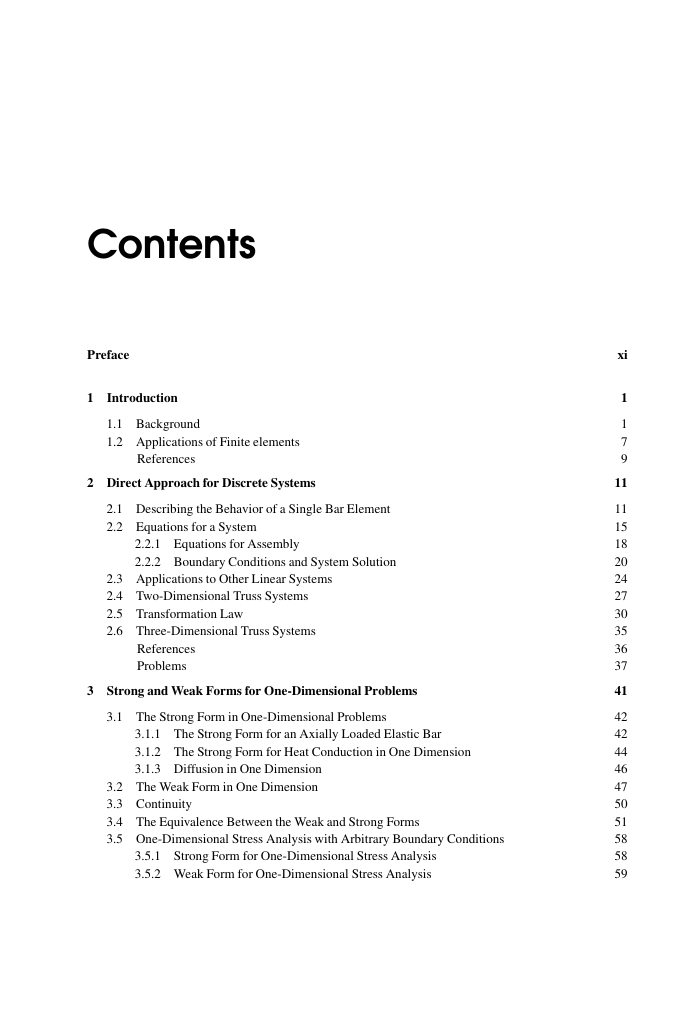A First Course in Finite Elements
Contents
Preface
1 Introduction
1.1 Background
1.2 Applications of Finite elements
References
2 Direct Approach for Discrete Systems
2.1 Describing the Behavior of a Single Bar Element
2.2 Equations for a System
2.2.1 Equations for Assembly
2.2.2 Boundary Conditions and System Solution
2.3 Applications to Other Linear Systems
2.4 Two-Dimensional Truss Systems
2.5 Transformation Law
2.6 Three-Dimensional Truss Systems
References
Problems
3 Strong and Weak Forms for One-Dimensional Problems
3.1 The Strong Form in One-Dimensional Problems
3.1.1 The Strong Form for an Axially Loaded Elastic Bar
3.1.2 The Strong Form for Heat Conduction in One Dimension
3.1.3 Diffusion in One Dimension
3.2 The Weak Form in One Dimension
3.3 Continuity
3.4 The Equivalence Between the Weak and Strong Forms
3.5 One-Dimensional Stress Analysis with Arbitrary Boundary Conditions
3.5.1 Strong Form for One-Dimensional Stress Analysis
3.5.2 Weak Form for One-Dimensional Stress Analysis
3.6 One-Dimensional Heat Conduction with Arbitrary Boundary Conditions
3.6.1 Strong Form for Heat Conduction in One Dimension with Arbitrary Boundary Conditions
3.6.2 Weak Form for Heat Conduction in One Dimension with Arbitrary Boundary Conditions
3.7 Two-Point Boundary Value Problem with Generalized Boundary Conditions
3.7.1 Strong Form for Two-Point Boundary Value Problems with Generalized Boundary Conditions
3.7.2 Weak Form for Two-Point Boundary Value Problems with Generalized Boundary Conditions
3.8 Advection–Diffusion
3.8.1 Strong Form of Advection–Diffusion Equation
3.8.2 Weak Form of Advection–Diffusion Equation
3.9 Minimum Potential Energy
3.10 Integrability
References
Problems
4 Approximation of Trial Solutions, Weight Functions and Gauss Quadrature for One-Dimensional Problems
4.1 Two-Node Linear Element
4.2 Quadratic One-Dimensional Element
4.3 Direct Construction of Shape Functions in One Dimension
4.4 Approximation of the Weight Functions
4.5 Global Approximation and Continuity
4.6 Gauss Quadrature
Reference
Problems
5 Finite Element Formulation for One-Dimensional Problems
5.1 Development of Discrete Equation: Simple Case
5.2 Element Matrices for Two-Node Element
5.3 Application to Heat Conduction and Diffusion Problems
5.4 Development of Discrete Equations for Arbitrary Boundary Conditions
5.5 Two-Point Boundary Value Problem with Generalized Boundary Conditions
5.6 Convergence of the FEM
5.6.1 Convergence by Numerical Experiments
5.6.2 Convergence by Analysis
5.7 FEM for Advection–Diffusion Equation
References
Problems
6 Strong and Weak Forms for Multidimensional Scalar Field Problems
6.1 Divergence Theorem and Green’s Formula
6.2 Strong Form
6.3 Weak Form
6.4 The Equivalence Between Weak and Strong Forms
6.5 Generalization to Three-Dimensional Problems
6.6 Strong and Weak Forms of Scalar Steady-State Advection–Diffusion in Two Dimensions
References
Problems
7 Approximations of Trial Solutions, Weight Functions and Gauss Quadrature for Multidimensional Problems
7.1 Completeness and Continuity
7.2 Three-Node Triangular Element
7.2.1 Global Approximation and Continuity
7.2.2 Higher Order Triangular Elements
7.2.3 Derivatives of Shape Functions for the Three-Node Triangular Element
7.3 Four-Node Rectangular Elements
7.4 Four-Node Quadrilateral Element
7.4.1 Continuity of Isoparametric Elements
7.4.2 Derivatives of Isoparametric Shape Functions
7.5 Higher Order Quadrilateral Elements
7.6 Triangular Coordinates
7.6.1 Linear Triangular Element
7.6.2 Isoparametric Triangular Elements
7.6.3 Cubic Element
7.6.4 Triangular Elements by Collapsing Quadrilateral Elements
7.7 Completeness of Isoparametric Elements
7.8 Gauss Quadrature in Two Dimensions
7.8.1 Integration Over Quadrilateral Elements
7.8.2 Integration Over Triangular Elements
7.9 Three-Dimensional Elements
7.9.1 Hexahedral Elements
7.9.2 Tetrahedral Elements
References
Problems
8 Finite Element Formulation for Multidimensional Scalar Field Problems
8.1 Finite Element Formulation for Two-Dimensional Heat Conduction Problems
8.2 Verification and Validation
8.3 Advection–Diffusion Equation
References
Problems
9 Finite Element Formulation for Vector Field Problems – Linear Elasticity
9.1 Linear Elasticity
9.1.1 Kinematics
9.1.2 Stress and Traction
9.1.3 Equilibrium
9.1.4 Constitutive Equation
9.2 Strong and Weak Forms
9.3 Finite Element Discretization
9.4 Three-Node Triangular Element
9.4.1 Element Body Force Matrix
9.4.2 Boundary Force Matrix
9.5 Generalization of Boundary Conditions
9.6 Discussion
9.7 Linear Elasticity Equations in Three Dimensions
Problems
10 Finite Element Formulation for Beams
10.1 Governing Equations of the Beam
10.1.1 Kinematics of Beam
10.1.2 Stress–Strain Law
10.1.3 Equilibrium
10.1.4 Boundary Conditions
10.2 Strong Form to Weak Form
10.2.1 Weak Form to Strong Form
10.3 Finite Element Discretization
10.3.1 Trial Solution and Weight Function Approximations
10.3.2 Discrete Equations
10.4 Theorem of Minimum Potential Energy
10.5 Remarks on Shell Elements
Reference
Problems
11 Commercial Finite Element Program ABAQUS Tutorials
11.1 Introduction
11.1.1 Steady-State Heat Flow Example
11.2 Preliminaries
11.3 Creating a Part
11.4 Creating a Material Definition
11.5 Defining and Assigning Section Properties
11.6 Assembling the Model
11.7 Configuring the Analysis
11.8 Applying a Boundary Condition and a Load to the Model
11.9 Meshing the Model
11.10 Creating and Submitting an Analysis Job
11.11 Viewing the Analysis Results
11.12 Solving the Problem Using Quadrilaterals
11.13 Refining the Mesh
11.13.1 Bending of a Short Cantilever Beam
11.14 Copying the Model
11.15 Modifying the Material Definition
11.16 Configuring the Analysis
11.17 Applying a Boundary Condition and a Load to the Model
11.18 Meshing the Model
11.19 Creating and Submitting an Analysis Job
11.20 Viewing the Analysis Results
11.20.1 Plate with a Hole in Tension
11.21 Creating a New Model
11.22 Creating a Part
11.23 Creating a Material Definition
11.24 Defining and Assigning Section Properties
11.25 Assembling the Model
11.26 Configuring the Analysis
11.27 Applying a Boundary Condition and a Load to the Model
11.28 Meshing the Model
11.29 Creating and Submitting an Analysis Job
11.30 Viewing the Analysis Results
11.31 Refining the Mesh
Appendix
A.1 Rotation of Coordinate System in Three Dimensions
A.2 Scalar Product Theorem
A.3 Taylor’s Formula with Remainder and the Mean Value Theorem
A.4 Green’s Theorem
A.5 Point Force (Source)
A.6 Static Condensation
A.7 Solution Methods
Direct Solvers
Iterative Solvers
Conditioning
References
Problem
Index
Colour Section
















 2023年江西萍乡中考道德与法治真题及答案.doc
2023年江西萍乡中考道德与法治真题及答案.doc 2012年重庆南川中考生物真题及答案.doc
2012年重庆南川中考生物真题及答案.doc 2013年江西师范大学地理学综合及文艺理论基础考研真题.doc
2013年江西师范大学地理学综合及文艺理论基础考研真题.doc 2020年四川甘孜小升初语文真题及答案I卷.doc
2020年四川甘孜小升初语文真题及答案I卷.doc 2020年注册岩土工程师专业基础考试真题及答案.doc
2020年注册岩土工程师专业基础考试真题及答案.doc 2023-2024学年福建省厦门市九年级上学期数学月考试题及答案.doc
2023-2024学年福建省厦门市九年级上学期数学月考试题及答案.doc 2021-2022学年辽宁省沈阳市大东区九年级上学期语文期末试题及答案.doc
2021-2022学年辽宁省沈阳市大东区九年级上学期语文期末试题及答案.doc 2022-2023学年北京东城区初三第一学期物理期末试卷及答案.doc
2022-2023学年北京东城区初三第一学期物理期末试卷及答案.doc 2018上半年江西教师资格初中地理学科知识与教学能力真题及答案.doc
2018上半年江西教师资格初中地理学科知识与教学能力真题及答案.doc 2012年河北国家公务员申论考试真题及答案-省级.doc
2012年河北国家公务员申论考试真题及答案-省级.doc 2020-2021学年江苏省扬州市江都区邵樊片九年级上学期数学第一次质量检测试题及答案.doc
2020-2021学年江苏省扬州市江都区邵樊片九年级上学期数学第一次质量检测试题及答案.doc 2022下半年黑龙江教师资格证中学综合素质真题及答案.doc
2022下半年黑龙江教师资格证中学综合素质真题及答案.doc